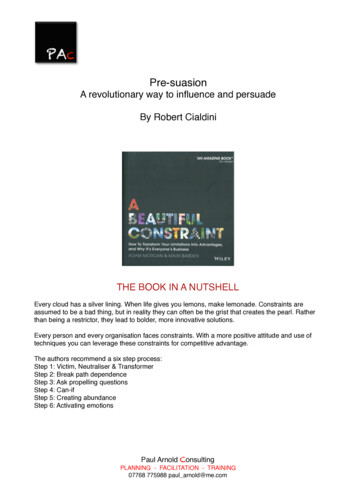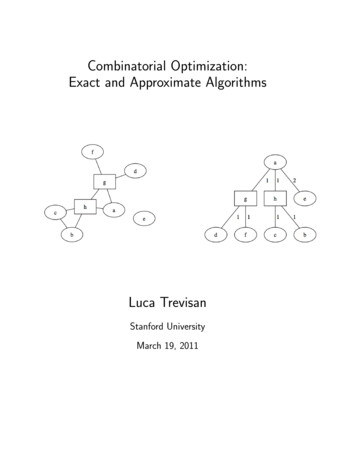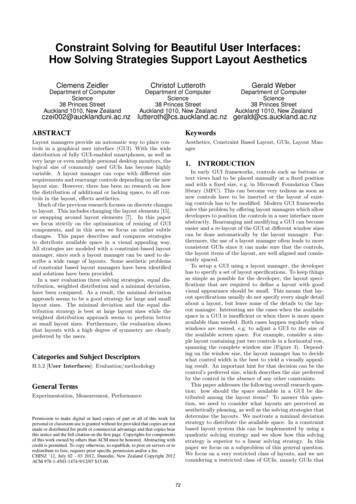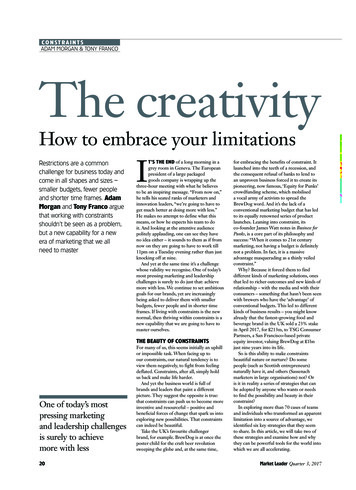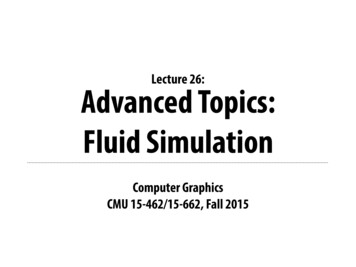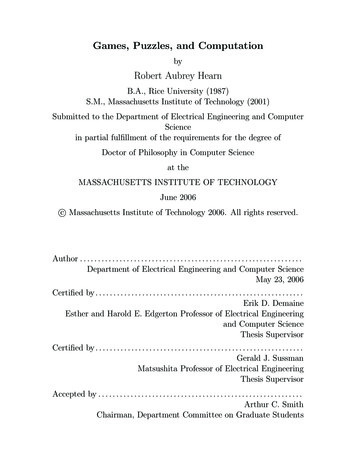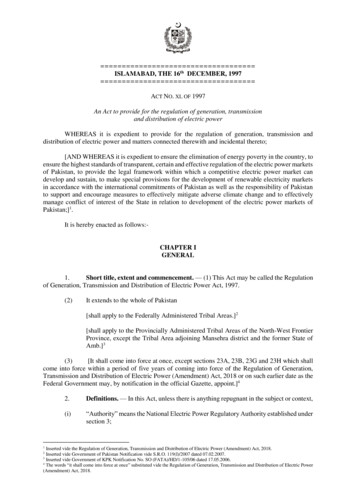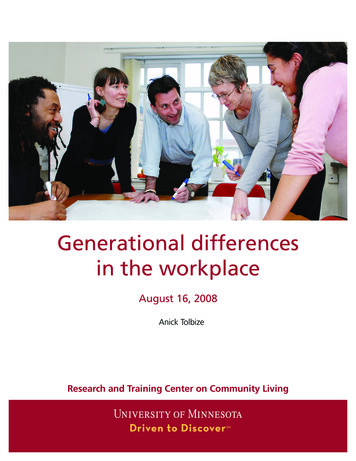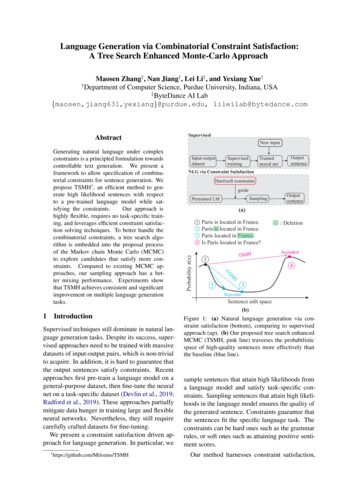
Transcription
Language Generation via Combinatorial Constraint Satisfaction:A Tree Search Enhanced Monte-Carlo ApproachMaosen Zhang† , Nan Jiang† , Lei Li‡ , and Yexiang Xue††Department of Computer Science, Purdue University, Indiana, USA‡ByteDance AI Lab{maosen,jiang631,yexiang}@purdue.edu, lileilab@bytedance.comSupervised techniques still dominate in natural language generation tasks. Despite its success, supervised approaches need to be trained with massivedatasets of input-output pairs, which is non-trivialto acquire. In addition, it is hard to guarantee thatthe output sentences satisfy constraints. Recentapproaches first pre-train a language model on ageneral-purpose dataset, then fine-tune the neuralnet on a task-specific dataset (Devlin et al., 2019;Radford et al., 2019). These approaches partiallymitigate data hunger in training large and flexibleneural networks. Nevertheless, they still requirecarefully crafted datasets for fine-tuning.We present a constraint satisfaction driven approach for language generation. In particular, ngTrainedneural netOutputsentenceNLG via Constraint SatisfactionHard/soft constraintsguideSamplingPretrained LMOutputsentence(a)1234Paris is located in France.Paris is located in France.Paris located in France.Is Paris located in France?TSMH1: 1New inputCGGenerating natural language under complexconstraints is a principled formulation towardscontrollable text generation. We present aframework to allow specification of combinatorial constraints for sentence generation. Wepropose TSMH1 , an efficient method to generate high likelihood sentences with respectto a pre-trained language model while satisfying the constraints.Our approach ishighly flexible, requires no task-specific training, and leverages efficient constraint satisfaction solving techniques. To better handle thecombinatorial constraints, a tree search algorithm is embedded into the proposal processof the Markov chain Monte Carlo (MCMC)to explore candidates that satisfy more constraints. Compared to existing MCMC approaches, our sampling approach has a better mixing performance. Experiments showthat TSMH achieves consistent and significantimprovement on multiple language generationtasks.SupervisedProbability π(x)Abstract23RejectedSentence edit space(b)Figure 1: (a) Natural language generation via constraint satisfaction (bottom), comparing to supervisedapproach (up). (b) Our proposed tree search enhancedMCMC (TSMH, pink line) traverses the probabilisticspace of high-quality sentences more effectively thanthe baseline (blue line).sample sentences that attain high likelihoods froma language model and satisfy task-specific constraints. Sampling sentences that attain high likelihoods in the language model ensures the quality ofthe generated sentence. Constraints guarantee thatthe sentences fit the specific language task. Theconstraints can be hard ones such as the grammarrules, or soft ones such as attaining positive sentiment scores.Our method harnesses constraint satisfaction,
rather than learning, to guide language generation.In fact, there is no task-specific training in ourapproach. Our approach is highly flexible sinceconstraints can be switched quickly to be adaptedto a different task, even faster than fine-tuning. Italso allows us to leverage the latest developmentsof automated reasoning for language generation.Although the field of language generation is dominated by learning, reasoning should play an equallyimportant role. Human beings can write beautifulwords from reasoning over what is needed in thespecific writing task, without learning from previous examples.To better handle the combinatorial constraints, atree search is embedded into the proposal processof the Markov chain Monte Carlo (MCMC) for constrained language generation, which suggests candidate proposals that satisfy more constraints. Our approach is motivated by Sample-Search (Gogate andDechter, 2007a,b, 2011), which integrates backtrack search into importance sampling. Makingmultiple word-level changes within one proposalstep of MCMC allows the direct transition betweenlegitimate sentences, while previous approachesmust go through infeasible intermediate states.Such moves are typically rejected by MCMC andtherefore result in a slow mixing rate (See Figure 1(b) and Section 3.1).In literature, constrained language generationhas been attacked in a supervised way in (Sutskeveret al., 2014; Berglund et al., 2015; Hu et al., 2017;Zhang et al., 2019; Miao et al., 2020). There arealso multiple works of literature which model language rules as decomposed tree structures (Leeet al., 2019) or sentiment tags (Su et al., 2018).Markov Logic network (Richardson and Domingos, 2006; Khot et al., 2015) are also used to formulate grammar rules. The distance between vectors representing sentences meaning is consideredas soft constraints in (Prabhumoye et al., 2018;Belanger and McCallum, 2016; Amato and MacDonald, 2010). In a nutshell, we summarize ourcontributions as follows:1. We define the problem of constraint satisfaction driven natural language generation, andpropose a sampling-based approach to tacklethe problem with combinatorial constraints.2. We propose a Tree Search enhancedMetropolis-Hastings approach (TSMH)for the proposed task, which mixes fasterthan standard MCMC in the presence ofcombinatorial constraints.3. Experiment results on generating interrogative, imperative sentences with keywords, andsentences with given sentiments demonstratethat our TSMH is able to generate sentencesthat satisfy more hard and soft constraints aswell as retain good quality.2Language Generation viaCombinatorial Constraint SatisfactionWe provide a general framework for the constrainednatural language generation. In this framework,sentences are generated by sampling from a probability distribution that is proportional to the score ofa pre-trained language model times the constraintscore. Formally, let x be a sentence, π(x) be theprobability that x is sampled, then π(x) should be:π(x) PLM (x) · Constraint(x).(1)Here, PLM (x) is the score of a language model(Sundermeyer et al., 2012; Radford et al., 2019),which measures the quality of sentence x. HigherPLM (x) means the sentence x is better in quality.Constraint(x) is a task-specific penalty term.For example, in interrogative sentences generation,we would enforce Constraint(x) to guarantee thatonly sentences in the interrogative form receivehigh scores. Constraints are composed of hard andsoft constraint terms:Constraint(x) Φhard (x) · Φsoft (x).(2)Both the hard constraint score Φhard (x) and thesoft constraint score Φsoft (x) are float values ranging from 0 to 1. The closer to 1, the more satisfiedthe constraints are.Unlike supervised methods which need to betrained with paired input-output data, our framework can solve language generation tasks withouttask-specific training. PLM (x) comes from a language model, only trained on general-purpose language tasks. There is no fine-tuning of PLM (x) onthe specific task. Φhard (x) is based on crafted constraints. Φsoft (x) comes from either user-definedfunctions, or pre-trained neural networks, whichagain is not fine-tuned on the specific task. Theoverall formulation composed of the languagemodel and the task-specific constraints allows usto sample sentences which are close to natural language while satisfying constraints.
2.1VHard ConstraintsIn this paper, we use propositional logic to definehard constraints Φhard (x). Nevertheless, our sampling approach generalizes to other logic forms. Weleave the generalization to first-order logic as futurework. For hard constraints, we define Φhard (x) asΦhard (x) βPM i ci (x)(3)where ci (x) is an indicator variable which takes 1 ifthe sentence x satisfies the i-th constraint, and M isthe total number of hard constraints. β is between0 and 1. We use quite small β values in our experiments, which put a large penalty on violating onehard constraint. We also define Constraint ErrorC(x) as the number of hard Pconstraints a sentenceviolates, i.e., C(x) M i ci (x). Constraintsare defined in the logical form of word categories.Word Category Division We divide the entire vocabulary into several categories of words.Given vocabulary set U , we partition U into nonoverlapping subsets: V {V1 , V2 , . . . , V V }, satisfying: (i) all Vi are subsets of U : Vi U, Vi V; (ii) categories are non-overlapping: Vi Vj , Vi , Vj V, i 6 j; (iii) Vi together cover theS V whole vocabulary: i Vi U .The word category division strategy varies fordifferent tasks. For example, we split the wholevocabulary into V {[QWH], [AUX], [OTH]}for generating interrogative sentences. Here,V1 [QWH] represents the set of wh-words leading a question: what, when, where, which, who,whom, whose, why, how. V2 [AUX] represents the set of auxiliary verbs and copula words:do, does, did, be, am, are, is, . . . , etc. V3 [OTH] means all other words in the vocabulary.We may use another division in, e.g., generating imperative sentences. Sometimes we needto generate sentences with keywords. We leteach keyword forms a category. For example,to generate interrogative sentences with the keyword learning, the division would be: V {[QWH], [AUX], [learning], [OTH]}.Hard Constraints Given a sentence with lengthVm 2 , let wi j {true, f alse} be an indicator variable that the i-th word in the sentence is in categoryVj . For example, variable w1[QWH] true if andonly if the first word in sentence is a wh-like word.For sentence-level constraints, we can define them2As we conduct sampling for the sentence, sentence lengthis pre-known and we set m as the length of the longest one.using propositional logic over wi j (and ( ), or( ), not ( )). We give a few examples below.Enforcing Keywords in a Sentence Given onekeyword K, we can enforce its existence in thesentence using the following constraint:[K]w1[K] w2[K] · · · wm.here [K] is a set containing the keyword K. We formulate this constraint assuming a known sentencelength m. Indeed, length m is a variable and canvary over the sampling procedure. Nevertheless,as we can see shortly in the sampling process, thelengths are known for both sentences when transiting from one sentence to another. Therefore, thesemantic meaning of m is clear during sampling.Details on the sampling process is in Section 3.2.Enforcing Imperative Sentence According to thedefinition in (Aarts, 1989), the starting word ofan imperative sentence should be either a verb:w1[VERB] or an adverb followed by a verb: w1[ADV] w2[VERB] . We encode such constraint as:w1[VERB] (w1[ADV] w2[VERB] ).Enforcing Interrogative Sentence We use the following two constraints to enforce the sentence tobe interrogative: (i) The first word is in [QWH].(ii) The second or third word in the sentence is in[AUX]. (i, ii) can be written together as:w1[QWH] ((w2[AUX] w3[AUX] ) (w3[AUX] w2[AUX] )).This constraint is similar to the definition in(Zhang et al., 2017). We acknowledge that thisis a relaxed constraint. Nevertheless, our samplingapproach also consider the score from languagemodel. These constraints accompanied with thelanguage model guide us to good interrogative sentences in practice.2.2Soft ConstraintsA soft constraint assigns a float value between 0and 1 to indicate how the constraint is satisfied.For tasks with only hard constraints, Φsoft (x) isset to 1.0. Soft constraints can be derived quiteflexibly. It can be from a user-defined function (see“sentence similarity” for an example), or from apre-trained neural network (see “sentiment score”):Sentence Similarity We can define a soft constraintfunction ensuring that the generated sentence xis close to the reference sentence y in semanticmeaning. For one word in sentence x, we first find
the closest word in sentence y by computing theircosine similarity. Then either the minimum or theaverage of these words’ cosine similarity is takenas the similarity score for sentence x and y.Sentiment Score We can enforce that the generatedsentence must have a given sentiment by enforcingthe value for the sentence from a sentiment analysismodel. The output score of a sentiment analysisneural net represents whether the sentence has apositive or negative sentiment. We use this scoreas a soft constraint to control the sentiment of generated sentence with positive or negative attitude.Notice that the sentiment analysis neural net is pretrained on a separate dataset and remains intact inour framework.This setup gives us additional flexibility. Tobe specific, if we need to generate sentences thatcontain keywords while having a given sentiment,it is difficult to find a large dataset of this type andthe performance of a pure learning approach maybe limited. To summarize, the main attribute ofthe constraint satisfaction framework is allowinga formulation using both hard and soft constraints,without the need of task-specific training or tuning.3Tree Search Enhanced MCMCMarkov chain Monte Carlo (MCMC) is a classicalapproach to sample sentences from probability distribution π(x) as defined in Equation 1. Startingfrom one sentence x, MCMC moves to the nextsentence x by first generating a sample x fromthe proposal distribution Q(x x) and then acceptx with the following acceptance rate A(x x): π(x )Q(x x ) A(x x) min 1,,(4)π(x)Q(x x)If sentence x is rejected, then the sample remainsat x. The distribution of samples will convergeto the sentence stationary distribution of Markovchain π(x). Previous work (Miao et al., 2019) proposes to use MCMC for constrained sentence generation, namely CGMH algorithm. Their proposaldistribution only suggests sentences with one-wordmodification. Nevertheless, CGMH cannot handlethe combinatorial constraints in our problem definition, because of the low acceptance ratio problem caused by the locality of the proposal distribution. In other words, the sampling process canonly visit a limited number of neighbors, thus theMarkov chain will easily be trapped at one infeasible state, resulting in a lot of rejections. We illustrate this problem in detail and hence motivate ourtree search embedded MCMC approach using thefollowing example.3.1Motivation: Breaking the low acceptancebarrierSuppose we need to generate a question, whose answer comes from an underlined part of a sentence.For example, suppose we underline France in thesentence:A: Paris is located in France.The question we would like to generate is:B: Which country is Paris located in?Under our constraint satisfaction framework, wedefine Constraint(x) so that real interrogative sentences such as question B would receive high probability in the defined π(x). Our constraints are: (i)the whole sentence is in the interrogative form. (ii)Paris and located must appear in the sentence. Werun MCMC starting from sentence A.It is hard for MCMC without tree search to generate question B in a reasonable time starting fromA. Because the edit distance between sentence Aand B is larger than 2, we cannot generate B fromA with one step of word insertion, removal, or replacement. In order for CGMH to reach B from A,it has to encounter a few intermediate steps. Without loss of generality, suppose CGMH proposessentence C in one MCMC step by removing is:C: Paris is located in France.Notice that C is not a legitimate English sentence, so its language model score PLM (x) becomes much smaller compared to the original sentence A. In addition, C violates more constraintsthan A, which decreases its Constraint(x) scoreas well. In MCMC, the probability to accept themove from A to sentence C is given by Equation 4, in which the dominating term is π(C)π(A) PLM (C) Constraint(C)PLM (A) Constraint(A) .Because both PLM (C) andConstraint(C) are smaller, the acceptance ratiobecomes really small. In fact, we found the acceptance ratio to be 5.93 10 12 in our experiment.This means that it will take CGMH many steps (onthe order of 1012 ) to move one step from sentenceA to C. Figure 2 (left) demonstrates this. It is easyto verify that barriers of low acceptance rate existon every path from sentence A to C and thus therejection problem exists.On the other hand, if we allow the proposal distribution to suggest sentences with multiple wordlevel changes, one can transit from sentence A toB through all legitimate sentences as intermediate
Tree Search Enhanced MCMC (𝒌 step, 𝒌 𝟐)CGMH (highly likely toreject intermediate states)Paris is located in France.Paris is located in France.Step 1R ID Step 2I R RAccept rate 𝟏𝟎!𝟏𝟐D Is Paris located in France?II Which city is located in France?What is located in France? DIDParis located in France.RR (A Single Proposal by Tree Search)D Is Paris located in France?Accept rate: 𝟏𝟎𝟎%Which country is Paris located in?Figure 2: Our method, tree search embedded MCMC (TSMH), outperforms CGMH in generating sentences withcomplex combinatorial constraints. (Left) CGMH must pass intermediate sentence states (highlighted in red),which have very low acceptance rate to reach the intermediate sentence Is Paris located in France? starting fromsentence Paris is located in France. This results in the poor performance of CGMH when handling combinatorialconstraints. (Right) By embedding a tree search into MCMC, TSMH can reach the an intermediate sentence fromthe starting sentence in one step, and with an acceptance rate of 100%. R, I, D mean replace, insert, delete. SeeSection 3.1 for a detailed discussion.steps. Consider the following two-step change:1. First delete is and insert is before Paris. Thischanges sentence A to D:Is Paris located in France?2. Delete France and insert Which and country.This changes sentence D to B.Because the intermediate step sentence D is alegitimate English sentence and Constraint(D) Constraint(A), π(D)π(A) is close to 1, resulting in a100% acceptance ratio in this step. When changingfrom D to B, notice that B is also a legitimatesentence and it satisfies more constraints than D.In fact, the acceptance ratio is also 100%. Figure 2(right) demonstrates this case.For tasks with soft constraints, there are also similar rejection problems for CGMH. For example,“Nothing is impossible” is a sentence with positivesentiment. If we insert, replace or delete one word,it is hard to keep the sentence valid and preservethe positive sentiment.Motivated by these examples, we propose theembed a tree search into the proposal process ofMCMC to solve the rejection problem, which suggests candidate sentences with multiple word-levelchanges and satisfy more constraints.3.2TSMH Algorithm ImplementationOur Tree Search enhanced Metropolis-Hastings(TSMH) still follows the classical MCMC procedure. The only difference is a new proposal distri-bution Q(x x) generated from a tree search process. The tree search defines a probability distribution over templates of sentence moves. Eachtemplate defines a subset of possible moves. Thesentences within the same template satisfy the samehard constraints score Φhard (x). The proposalprobability distribution induced by the tree searchalgorithm biases towards templates that have highConstraint(x) scores.A template defines a set of sentences whereeach word is either given or specified bya word category. For example, a template[[QWH],[AUX],[OTH],[OTH]] restricts thatthe first word must be a wh-word, the second wordmust be an auxiliary verb and the last two wordsmust be other words.Notice that we can decide how many hardconstraints a sentence satisfies at the templatelevel, since the indicator variables in the constraints defined in this paper only restrict the categories of words. For example, the template[[QWH],[AUX],[OTH],[OTH]] satisfies theconstraints of being an interrogative sentence defined in Section 2. Our proposal procedure firstsample a template and then fills in this templatewith words based on a language model.Overview of the Proposal Process During thesampling process, suppose we are at one sentencex. We will sample a new sentence x from the proposal distribution as follows. First, our algorithmwill decide the positions of the words to change
by random selection. Typically, our algorithm willchange more than one word. Then we use a treesearch, which enumerates all possible operationson the selected words. This includes deciding theoperation on each word (insert, delete, or replace)as well as the associated word category in case ofinsert and replacement. In this case, every leafbranch of the search tree will be a sentence template. Because the number of word categories islimited, the tree search procedure is often cheap.As discussed, we can infer the number of hard constraints satisfied based on the template associatedwith each tree leaf. We then rank these templatesbased on the number of constraints satisfied andsample one template based on a geometric series,favoring templates that satisfy more constraints. Finally, we fill in the sampled template with wordssuggested by a language model, and then select onefilled sentence x̂ as proposal, according to the language model score times the soft constraint scorePLM (x̂) · Φsoft (x̂). Soft constraints Φsoft (x) giveus a real number, which is similar to the languagemodel PLM (x). We treat them together with thelanguage model in the proposal process.Our approach alleviates the rejection problemof MCMC by enumerating all possibilities in thespace of multiple word change at the templatelevel, based on the analysis in section 3.1. Thisprocess enables us to handle combinatorial constraints. Tree search also allows us to prune uselessbranches.3.2.1InputParis islocatedinFrance𝑥1𝑥3𝑥4𝑥5𝑥2Randomly select 𝑘 positions to operatePosition Parisislocated in FranceSearch𝛼1 𝛼2𝒙𝟏𝒙𝟐𝛼1 , 𝛼2 {𝐼, 𝑅, 𝐷, 𝑁}(insert, replace, delete, none)𝑊1 , 𝑊2 𝒱 {[QWH],[AUX],[OTH]}(new words to be insert or replace)𝑪(𝒙)Template.II[QWH][OTH][QWH] Paris [OTH] is located in France1IR[QWH][OTH][QWH] Paris [OTH] located in France1ID[QWH]-[QWH] Paris located in France2RI[QWH][OTH][QWH] [OTH] is located in France0RN[QWH]-[QWH] is located in France0.RankRank by 𝑪(𝒙) (#Constraint Errors)𝑷groupGroupTemplate0[QWH] [OTH] is located in France(1 𝛽)𝛽 0[QWH] is located in FranceSelectedGroup.1[QWH] Paris [OTH] is located in France(1 𝛽)𝛽1[QWH] Paris [OTH] located in France.2[QWH] Paris located in France(1 𝛽)𝛽 2.Group Selection: Select Group 𝑖 with probability (1 𝛽)𝛽 𝑖Template Selection (in the selected group)Fill Sentence with BERT𝑷LM 𝚽softWhich city is located in France?1.9 10 10What is located in France?2.5 10 16.Randomly select one as proposalProposal: Which city is located in France?Figure 3: The proposal process of Tree Search Embedded MCMC. The input is the current sentence (state)and the output is the proposed sentence. This proposalprocess favors sentences satisfying a large number ofconstraints.Detailed Search ProcedureThe procedure of searching proposals in our treesearch embedded MCMC is as follows and shownin Figure 3.Position Randomly select k positions {t1 , . . . , tk }to perform word-level operations with uniformprobabilities, where k is the size of the search steps.The probability of getting each combination of positions is: Ppos 1/ mk , where m is the length ofthe sentence.Search Search and iterate all different operationsand all different word categories (mentioned in Section 2.1) for each selected position. For example, ifwe have V word categories and the operation set{replace, insert, delete, none} , we need to enumerate (2 V 2)k different combinations of operationsand word categories. We use word placeholders[MASK] to represent the unknown inserted or replaced words. We keep track of all the generatedtemplates and their corresponding numbers of vio-lated constraints.Rank and Group Selection We define a group asthe set of templates which violate the same numberof constraints. We sort all templates by its numberof violated constraints (constraint error) C in ascending order, and put templates with the same Cinto one group. We then randomly select group iwith probability: Pgroup (1 β) · β Ci minj Cj ,where Ci is the constraint error of group i, and βis a very small float value (like 10 10 ). In this way,we favor choosing the group satisfying the largestamount of constraints, while also ensuring the irreducibility of the Markov chain. Let the chosengroup at this step be Gi .Fill and Template Selection In this step we willfirst fill every template with words in the selectedgroup Gi , then we select one filled template as theproposal. Because the template restricts the maskedword to be chosen only from the corresponding
word category, we fill it by selecting words fromthe given word category. The probability of selecting the ti -th word PFilli is the conditional probability of filling words at this locations given contexts: PLM (xti x1 , ., xti 1 , xti 1 , ., xm ). TheprobabilityQ of getting one sampled sentence is:Pfill ki 1 Pfilli , where i means the word levelaction for i-th position we selected. If the operationin ti is delete or none, then Pfilli 1. We sampleone template within the group (together with thecorresponding sampled sentence) according to thesentence probability times soft constraint score: )·Φ soft (x )Ptemplate P PLM (xPLM (x̂)·Φsoft (x̂) .x̂ GiThe proposal distribution Q(x x) leading fromsentence state x to x in this procedure isQ(x x) Ppos Pgroup Pfill Ptemplate .4ExperimentsWe evaluate our approach on three applications:interrogative, imperative, and fixed sentiment sentences generation. In each task, we construct thespecified type of sentences by sampling startingfrom keywords and enforcing task-specific constraints. For each task, we run our TSMH algorithm for 100 steps, with 100 candidate sentencesgenerated. k is set to 3. Since the tree search inTSMH considers changing 3 words at each iteration, we run the baseline CGMH for 300 stepsas a comparison. We select the sentence with thehighest π(x) value among the sentences generatedby each algorithm as the output. Our results aresummarized in Table 1.In general, our method TSMH outperforms baselines and generates sentences that satisfy more constraints, are of good quality and are likely to beclose to the natural language. Our main results aresummarized in Table 1, in which Valid% denotesthe percentage of generated sentences that satisfyall constraints. π(x) is the value of the stationaryprobability PLM (x) · Constraint(x). PGPT 2 (x)is language model probability estimated by a pretrained GPT-2 model, which measures the qualityof the sentences. Accept% means the acceptancerate of MCMC. Detailed experiment settings canbe reviewed in appendix A.1.4.1Interrogative Sentence GenerationIn the interrogative sentence generation, we construct interrogative sentences by sampling startingfrom the keywords. We enforce that sentences witha high probability to be sampled must satisfy gram-mar constraints of being interrogative and containa few given keywords. The constraint definition forinterrogative sentences is in section 2.1.According to the results, in the experiment withkeywords, 92.67% of the output sentences of ourTSMH algorithm satisfy all the constraints, whilemerely 18.33% satisfy constraints for the baseline.The numbers are 83.17% and 45.50% for the experiment without keywords, respectively. This demonstrates that our TSMH generates sentences withmore constraints satisfied. In addition, our methodhas a higher π(x) (stationary probability value) andacceptance rate, suggesting that the tree search embedded help MCMC to mix faster. Overall, ourmethod TSMH can handle more complicated constraints in language generation tasks.Human Evaluation We conduct human evaluation for interrogative sentences generated withkeywords. We present human participants fromthe Amazon Mechanical Turk with a pair of sentences at a time. One sentence is generated byour TSMH model and the other one is from thebaseline CGMH. We ask human participants whichsentence is better in terms of fluency and grammar.In terms of the experimental setting, we use 100sentence pairs generated by CGMH and TSMHwith the same keyword inputs. We randomly splitthese 100 test sentence pairs into 5 survey groups,and then deploy them on the Amazon MechanicalTurk. We randomly assign human participants tosurvey groups. When showing the sentence pairs,we also provide the keywords that the sentencesmust contain. We ask human participants to votewhich sentence in the pair is better in terms of grammar coherence, keyword coverage and fluency. Weuse a gold-standard question to detect if the voteris randomly doing the survey. Every valid surveycontains a randomized set of 20 questions. Wereceived in all 580 votes. Each question pair receives votes ranging from 5 to 11. As shown inTable 2, sentences from our model receive almosttwice times of votes than the baseline, which suggests that the sentences generated by our approachis better in human evaluation.Case Studies As shown in Table 3, we comparesome output sentences of our method with the baseline using the same inputs and keywords. Moreexamples can be seen in the appendix A.2. Fromthese cases, we can see that our method generatessentences with better quality.Comparison with Other Methods We compare
Methods#samplestepValid%π(x)PGPT 2 (x)Accept%InterrogativeCGMHTSMH 5.51E-185.45%24.50%ImperativeCGMHTSMH E-155.49%15.66%SentimentCGMHTSMH 1.82E-186.72%11.09%TasksTable 1: Our method TSMH outperforms CGMH by generating sentences that satisfy more constraints, are ofgood quality and are likely to be natural language. Column Valid% shows the percentage of generated sentencesthat satisfy all constrai
Constraint(x) is a task-specific penalty term. For example, in interrogative sentences generation, we would enforce Constraint(x) to guarantee that only sentences in the interrogative form receive high scores. Constraints are composed of hard and soft constraint terms: Constraint(x) hard(x) soft(x): (2) Both the hard constraint score hard(x .
